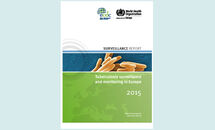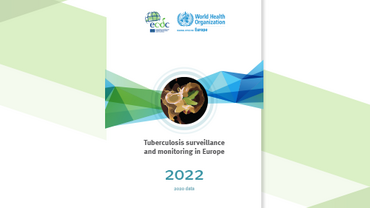Tuberculosis surveillance and monitoring in Europe 2015
The seventh report launched jointly by ECDC and the WHO Regional Office for Europe indicates that, despite notable progress in the past decade, tuberculosis (TB) is still a public health concern in many countries across Europe.
In 2013, 64 844 cases of TB were reported in 30 EU/EEA countries, which was 6% less than in 2012, reflecting a decrease in 19 countries. The EU/EEA notification rate was 12.7 per 100 000 population, continuing a long-term decreasing trend.
The latest figures on tuberculosis are available via ECDC’s Surveillance Atlas of Infectious Diseases, a web-based tool offering access to European infectious disease surveillance data which is searchable by disease, region and period.
Executive summary
In 2013, 64 844 tuberculosis cases were reported by 30 EU/EEA Member States, according to new data published today by the European Centre for Disease Prevention and Control and the WHO Regional Office for Europe. The notification rate of 12.7 per 100 000 population observed in 2013 constitutes a 6% decrease compared to the previous year, when some 68 000 cases were notified.
The overall downward trend within the European Union and European Economic Area (EU/EEA) is influenced by a marked decline of TB in high-incidence countries such as Romania, which accounts for 26% of all reported cases in the EU/EEA, whereas in some low-incidence countries like Denmark, Norway and Sweden, notification rates are actually going up.
“Our data show a Europe in need of tailored interventions which target each country’s settings”, says ECDC Director Marc Sprenger ahead of World TB Day. Despite historically low numbers and a significant decline over the last ten years, the EU/EEA countries are not all progressing in the same way and face specific challenges in their TB control efforts. In most low-incidence countries, rates are stable or going down only very slowly and the majority of patients are of foreign-origin. Countries with high incidence overall face higher rates of re-infection and relapses and report many more multidrug-resistant (MDR TB) cases.
According to the new data, only 4% of TB cases tested for drug-resistance are MDR TB. However, treatment success rates for these cases are very low and have remained unchanged over the past 10 years.
TB elimination still too far away
“At the current pace of an annual 6% decline, the EU/EEA will only be free of tuberculosis in the next century. In order to achieve elimination by 2050 for example, we would have to cut down cases at least twice as fast”, warns Sprenger. In order to achieve TB elimination, current tools and interventions like early diagnosis, correct treatment and contact tracing have to be used more efficiently. In a next step, the currently available tools have to be complemented by new and more effective ones, including better diagnostic tools, shorter treatment and an effective vaccine.
ECDC working with countries
The goal of TB prevention and control will be one of the main topics of the first Ministerial Conference on TB and MDR TB, to be held in Riga on 30-31 March under the Latvian EU Council Presidency, and where ECDC will be participating. On 1-2 April, a technical meeting organized by ECDC and the Centre for Disease Prevention and Control of Latvia will discuss how to address TB and MDR TB in high-priority countries.
Download

Publication data
Data
Country profile for Austria
Tuberculosis surveillance and monitoring in Europe 2015 - country profile for Austria
Data
Country profile for Belgium
Tuberculosis surveillance and monitoring in Europe 2015 - country profile for Belgium
Data
Country profile for Bulgaria
Tuberculosis surveillance and monitoring in Europe 2015 - country profile for Bulgaria
Data
Country profile for Croatia
Tuberculosis surveillance and monitoring in Europe 2015 - country profile for Croatia
Data
Country profile for Cyprus
Tuberculosis surveillance and monitoring in Europe 2015 - country profile for Cyprus
Data
Country profile for Czech Republic
Tuberculosis surveillance and monitoring in Europe 2015 - country profile for Czech Republic
Data
Country profile for Denmark
Tuberculosis surveillance and monitoring in Europe 2015 - country profile for Denmark
Data
Country profile for Estonia
Tuberculosis surveillance and monitoring in Europe 2015 - country profile for Estonia
Data
Country profile for Finland
Tuberculosis surveillance and monitoring in Europe 2015 - country profile for Finland
Data
Country profile for France
Tuberculosis surveillance and monitoring in Europe 2015 - country profile for France
Data
Country profile for Germany
Tuberculosis surveillance and monitoring in Europe 2015 - country profile for Germany
Data
Country profile for Greece
Tuberculosis surveillance and monitoring in Europe 2015 - country profile for Greece
Data
Country profile for Hungary
Tuberculosis surveillance and monitoring in Europe 2015 - country profile for Hungary
Data
Country profile for Iceland
Tuberculosis surveillance and monitoring in Europe 2015 - country profile for Iceland
Data
Country profile for Ireland
Tuberculosis surveillance and monitoring in Europe 2015 - country profile for Ireland
Data
Country profile for Italy
Tuberculosis surveillance and monitoring in Europe 2015 - country profile for Italy
Data
Country profile for Latvia
Tuberculosis surveillance and monitoring in Europe 2015 - country profile for Latvia
Data
Country profile for Lithuania
Tuberculosis surveillance and monitoring in Europe 2015 - country profile for Lithuania
Data
Country profile for Luxembourg
Tuberculosis surveillance and monitoring in Europe 2015 - country profile for Luxembourg
Data
Country profile for Malta
Tuberculosis surveillance and monitoring in Europe 2015 - country profile for Malta
Data
Country profile for Netherlands
Tuberculosis surveillance and monitoring in Europe 2015 - country profile for Netherlands
Data
Country profile for Norway
Tuberculosis surveillance and monitoring in Europe 2015 - country profile for Norway
Data
Country profile for Poland
Tuberculosis surveillance and monitoring in Europe 2015 - country profile for Poland
Data
Country profile for Portugal
Tuberculosis surveillance and monitoring in Europe 2015 - country profile for Portugal
Data
Country profile for Romania
Tuberculosis surveillance and monitoring in Europe 2015 - country profile for Romania
Data
Country profile for Slovakia
Tuberculosis surveillance and monitoring in Europe 2015 - country profile for Slovakia
Data
Country profile for Slovenia
Tuberculosis surveillance and monitoring in Europe 2015 - country profile for Slovenia
Data
Country profile for Spain
Tuberculosis surveillance and monitoring in Europe 2015 - country profile for Spain
Data
Country profile for Sweden
Tuberculosis surveillance and monitoring in Europe 2015 - country profile for Sweden
Data
Country profile for United Kingdom
Tuberculosis surveillance and monitoring in Europe 2015 - country profile for United Kingdom







